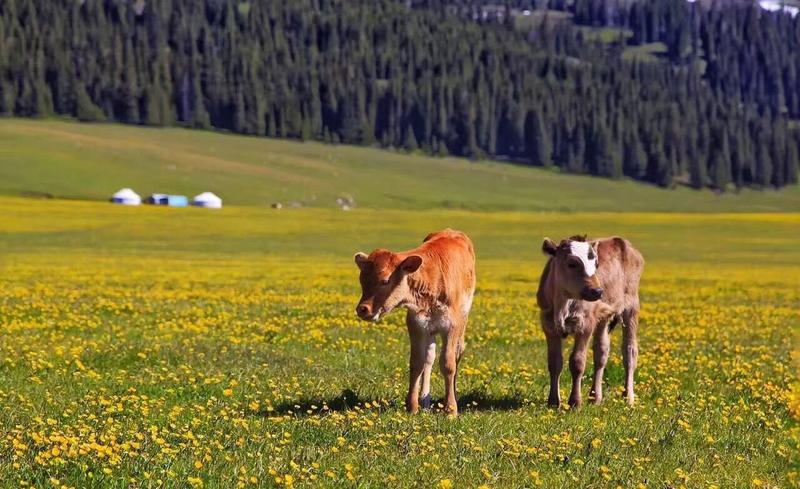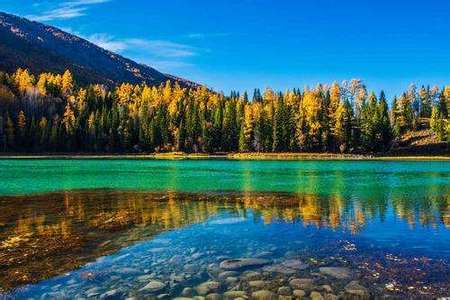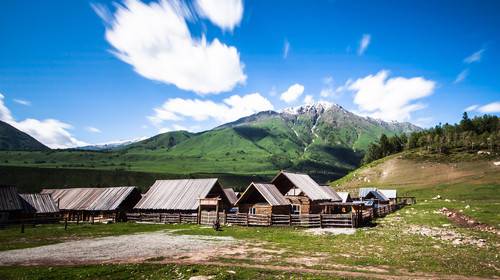Altay Burqin Ashan Deer King Cultural Park
On the way from Burqin County to Kanas, you will pass by Ashan Deer King Cultural Park and Baisha Mountain Desert Scenic Area. If time permits, you can take a break and explore. Driving along the S232 line for about 60 kilometers, you will pass through Chonghuer Town in the basin between two mountains, where you can have lunch and visit the farmers' market.
Baisha Mountain Desert Scenic Area
Along the Buka (Burqin-Kanas) highway, heading north for more than 10 kilometers, observant travelers will be pleasantly surprised to find a series of silver sand dunes of varying heights and sizes stretching into the distance on the right side of the road. This is a unique landscape in Burqin - Baisha Mountain.
Jiadengyu National Forest Park is located in Burqin County, Altay Prefecture, Xinjiang. The park is characterized by dense forests, vast grasslands, winding mountains, blue skies, white clouds, forests, and grasslands that blend together to form the typical natural scenery of Xinjiang. The low mountain and river valley areas below an altitude of 1500 meters have narrow and steep terrain, with cliffs, deep valleys, rapids, gorges, rivers, and green trees weaving picturesque corridors.
Kanas Lake is famous for its 'water monster'. The lake water is clear and green, surrounded by mountains. In summer, the lakeside is lush with green trees, and in autumn, it turns into a golden, dazzling sight, comparable to a fairy tale world. The Fish Viewing Pavilion is the best viewpoint in the Kanas Lake Scenic Area, offering a panoramic view of the Kanas scenery and is not to be missed. There are three ways to reach it: walk from the transfer center, which takes 2 to 3 hours one way; rent a horse at the transfer center and ride up the mountain; or buy a ticket to take the shuttle bus to halfway up the mountain, then walk up thousands of steps to the top.
The 'Three Bays' scenic spots—Wolong Bay, Moon Bay, and Fairy Bay. This is the essence of the Kanas River landscape, featuring three river beach attractions with varying widths and drops, each offering unique scenery. The Wolong Bay section has a relatively wide river channel, with water as smooth as a mirror, and a small island in the center resembling a lying dragon. Moon Bay winds along the mountain terrain, forming a beautiful curve. Fairy Bay is the main highlight, often shrouded in mist among the mountains, water, and trees, creating a fairyland-like atmosphere.
Shenxian Bay
Shenxian Bay is the biggest highlight among the three bays. Clouds often linger among the mountains, waters, and trees, making it feel like a fairyland. The altitude here is 5380 meters, with an average annual temperature below zero degrees. The maximum temperature difference between day and night is over 30 degrees. The winter lasts for more than six months, and half of the year experiences winds over 17 meters per second. The oxygen content in the air is less than 45% of that at sea level, while the ultraviolet intensity is 50% higher. This place is truly a 'plateau on the plateau'.
Moon Bay meanders along the mountain terrain, forming a graceful curve. It is the most famous attraction in Kanas, located about 1 kilometer north of Wolong Bay along the Hanas River. It is an extension of the Wolong Bay river bend. The beautiful and tranquil Moon Bay changes with the Kanas Lake water, truly a pearl embedded in the Kanas River.
Guan Yu Pavilion
Guan Yu Pavilion is the best viewing point in the Kanas Lake Scenic Area, offering a panoramic view of the Kanas beauty, and is not to be missed. There are three ways to reach it: walk from the transfer center, which takes 2 to 3 hours one way; rent a horse at the transfer center and ride up the mountain; or buy a ticket to take the shuttle bus to the halfway point, then hike up thousands of steps to the top.
Baihaba Village
Baihaba Village still maintains its original lifestyle, with pointed wooden houses and wooden fences enclosing livestock, exuding a rustic charm. Walking through the village, one can smell the scent of straw and earth. Behind the village, there are forests of birch and poplar trees, which turn golden in autumn, offering the best scenery. If you choose to stay overnight in Baihaba, be sure to prepare for cold weather.
Hemu Village
Hemu Village is a settlement inhabited by the Tuvan and Kazakh ethnic groups. It resembles an enlarged version of Baihaba, with log cabins and Kazakh yurts scattered throughout the village, harmonizing with the distant mountains, grasslands, and birch forests. The Hemu River flows to the west of Hemu Village and can be crossed via the Hemu Bridge to the south of the village or the Aid Xinjiang Bridge to the north. On the other side of the river lies a vast birch forest. The Hemu Bridge is a landmark of this village, having withstood a century of glacial meltwater from Kanas, and is both rustic and sturdy. You can hike through the birch forest to climb the mountain and reach the viewing platform, or opt to ride a horse up the mountain. This is the best spot to capture the sunrise over the Hemu Valley.























